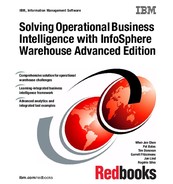
134 Solving Operational Business Intelligence with InfoSphere Warehouse Advanced Edition
your cube model and cube service definition. You can then retest it until the cube
service is correct. Figure 4-30 shows what this cube service looks like.
Figure 4-30 Viewing a running cube service in Design Studio
4.4.3 Deploy a cube model to InfoSphere Warehouse as a cube
service
After the cube model and the test cube service are defined, you need to deploy
this cube service into the runtime element of our InfoSphere Warehouse. The
cubing development process has so far been about defining the OLAP objects
that portray the cube within Design Studio. To deploy these OLAP objects as a
cube service, perform these three main functions:
???? Transfer the OLAP cube definition to the InfoSphere Warehouse metadata
repository, and create an export XLML file.
???? Define a cube within the InfoSphere Warehouse administration console by
loading the XML file.
???? Start and manage the cubing service from within the InfoSphere Warehouse
administration console.

Chapter 4. Data modeling: End to end 135
Follow these steps to export the cube model within Design Studio:
1. Start Design Studio and open the warehouse project that is used to develop
the cube service.
2. Go to File -> Export to bring up the Export wizard. Select the Data
Warehouse folder, then OLAP Metadata. Click Next.
3. Input the details of a user who has access to the InfoSphere metadata
repository. In the next panel (Figure 4-31), specify the OLAP object to be
exported and give the export file a name. We use
INDIVIDUAL_CST_DYN_FACT. Click Finish.
Figure 4-31 Export the cube model to the InfoSphere Administration Console
We have now exported our cube model. The next stage is to import this model
into the InfoSphere Data Warehouse Administration Console and create a cube
service, as follows:
1. Open the Data Warehouse Administration Console from a web browser. Log
in as a valid user. Click Open to expand the navigation menu and select the
Cubing Services tab.
2. To run the cube service, you need a cube server. To create a cube server,
click Manage Cube Server to be on the right page. Next, click the create

136 Solving Operational Business Intelligence with InfoSphere Warehouse Advanced Edition
button ( ), which is shown as a small yellow diamond on the tools menu. A
pop-up panel appears. Enter a name for the cube server you are creating, the
host name on which the cube server will run, and a port number, which is
9214. For the next few panels, keep the default options by clicking Next until
the end. Then click Finish to complete the creation process.
3. To start the new cube server, highlight the newly created cube server and
then click the green play icon( ) as shown in Figure 4-32.
Figure 4-32 Define a cube sever in the InfoSphere Data Warehouse Administrator Console
4. Import the cube service into this cube server. Select Manage Cube Models
to open a new panel, then select Import Cube Model. A wizard panel opens
asking for the data source of the base data. In our case, this is IWHPRD82.
Click Next.
5. Select the XML file created within Design Studio. Our file is
INDIVIDUAL_CST_DYN_FACT.xml. Click Next. The input file is read and a
Stop
button
Create
button
Start
button
Cube server
created
Port
number
assigned

Chapter 4. Data modeling: End to end 137
list of the included cube models and associated cubes is displayed. See
Figure 4-33.
Click Next, then Finish to import the cube model. The new cube model now
appears in the list.
Figure 4-33 Importing the cube models into the Administration Console
6. Load the cube model into the cube server and start the new cube service.
Start by returning to the “Manage Cube Servers” panel and selecting the
defined cube server. Then select Manage Cubes. A new wizard appears.
7. From the first panel of this wizard, select the green plus (+) icon to load into
this server a cube service from the loaded models; see Figure 4-34 on
..................Content has been hidden....................
You can't read the all page of ebook, please click here login for view all page.
